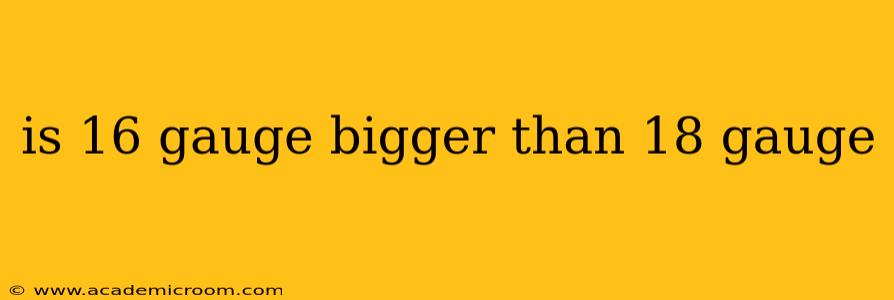The simple answer is yes, 16 gauge wire is thicker and bigger than 18 gauge wire. This is a common question, particularly for those working with electrical wiring, jewelry making, or other applications involving metal wire. Understanding gauge numbers and their relationship to wire diameter is crucial for selecting the appropriate material for your project.
Let's delve deeper into the concept of wire gauge and explore some frequently asked questions.
How Does Wire Gauge Work?
Wire gauge is a standardized system used to describe the diameter of a wire. The system is a bit counterintuitive: the smaller the gauge number, the thicker the wire. This means a 16-gauge wire has a larger diameter than an 18-gauge wire. The gauge system originated in the early days of wire manufacturing and is based on a logarithmic scale. This means the difference between gauges isn't a constant increase or decrease in diameter, but rather a proportional change.
Why is a Smaller Gauge Number Bigger?
The historical origins of the gauge system explain this seemingly backward numbering. The system was developed before precise measuring tools were widely available. As manufacturers drew wire through progressively smaller dies (holes), they assigned numbers to each stage of drawing. The thinner the wire became, the higher the number assigned to it, thus resulting in the smaller gauge number equating to thicker diameter wire.
What are the applications of different gauges?
The choice of gauge depends on the intended application. Thicker wires (smaller gauge numbers) are generally used where higher current carrying capacity is required, such as in electrical wiring for high-power appliances. Thinner wires (larger gauge numbers) are suitable for applications where lower current is needed, such as in smaller electronics or delicate jewelry.
Here are some examples:
- 16 Gauge: Commonly used for household wiring in some regions (check local electrical codes), appliance cords, and some types of jewelry making.
- 18 Gauge: Often used for extension cords, smaller appliances, and more delicate jewelry pieces.
Remember to always consult relevant standards and codes for your specific application to ensure safety and compliance.
What is the difference in diameter between 16 gauge and 18 gauge wire?
The exact diameter varies slightly depending on the material (copper, aluminum, etc.), but the difference is significant enough to be noticeable. While precise measurements require specialized tools, you can generally expect a 16-gauge wire to be substantially thicker than an 18-gauge wire.
What if I use the wrong gauge wire?
Using the wrong gauge wire can have serious consequences, particularly in electrical applications. Using wire that is too thin for a given current can lead to overheating, potentially causing fires or equipment damage. Using wire that is too thick may not necessarily be dangerous, but it may be wasteful and less efficient. Always follow the manufacturer's recommendations and local electrical codes.
Conclusion
Understanding wire gauge is essential for various applications, from electrical work to crafting. Remember that smaller gauge numbers mean thicker wires, with 16 gauge being thicker and stronger than 18 gauge. Always select the appropriate gauge based on the intended application and relevant safety standards.
